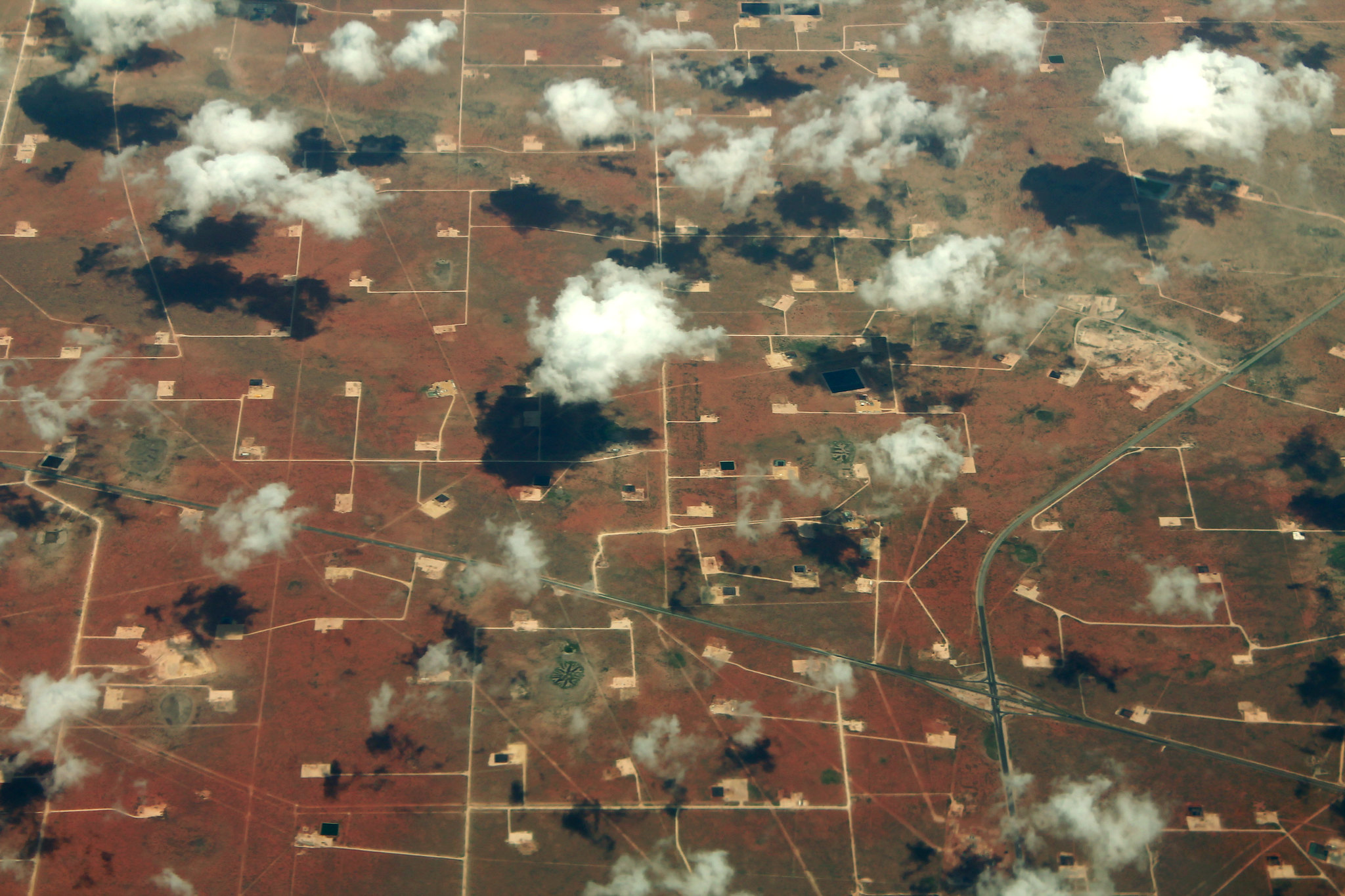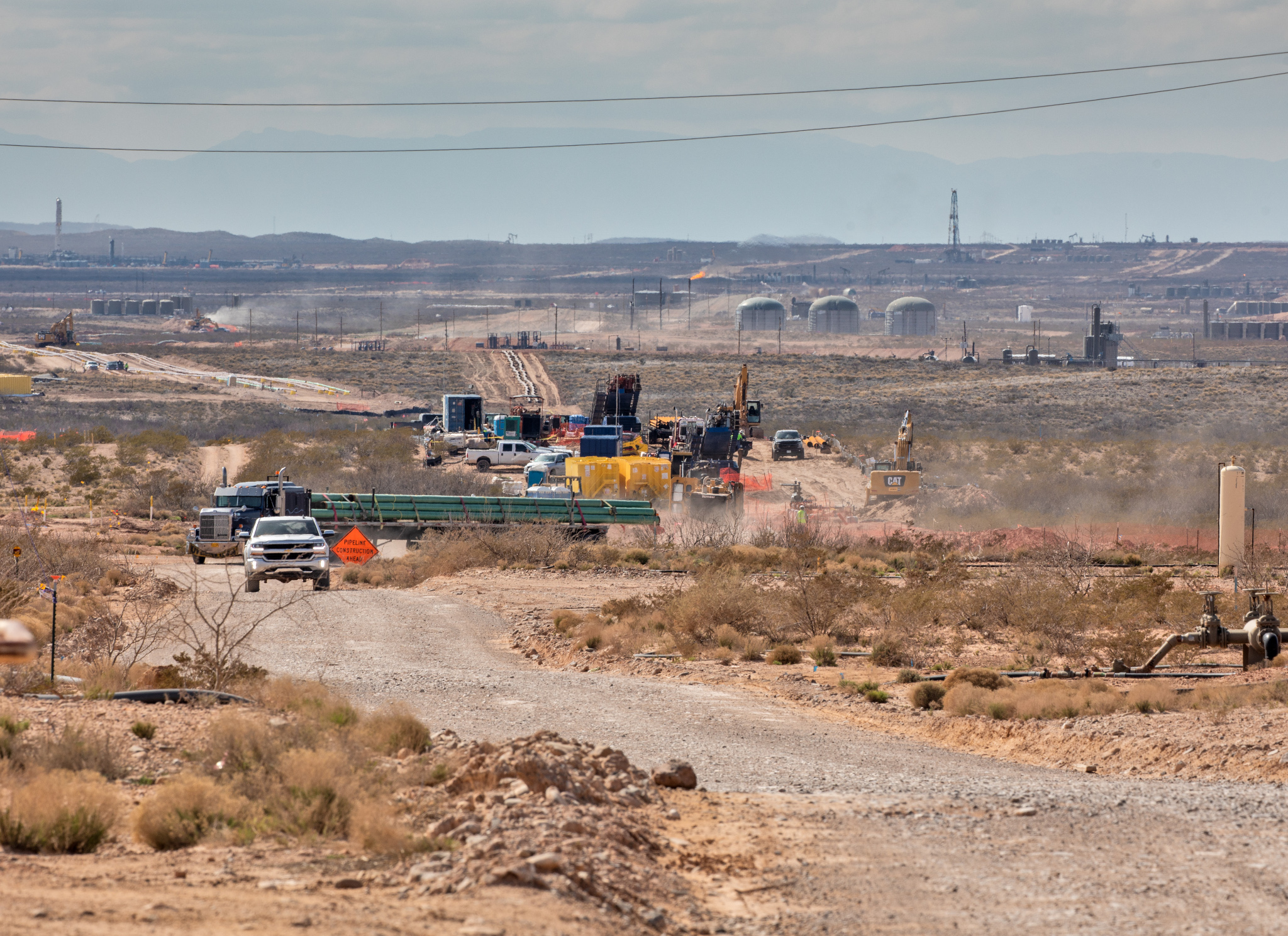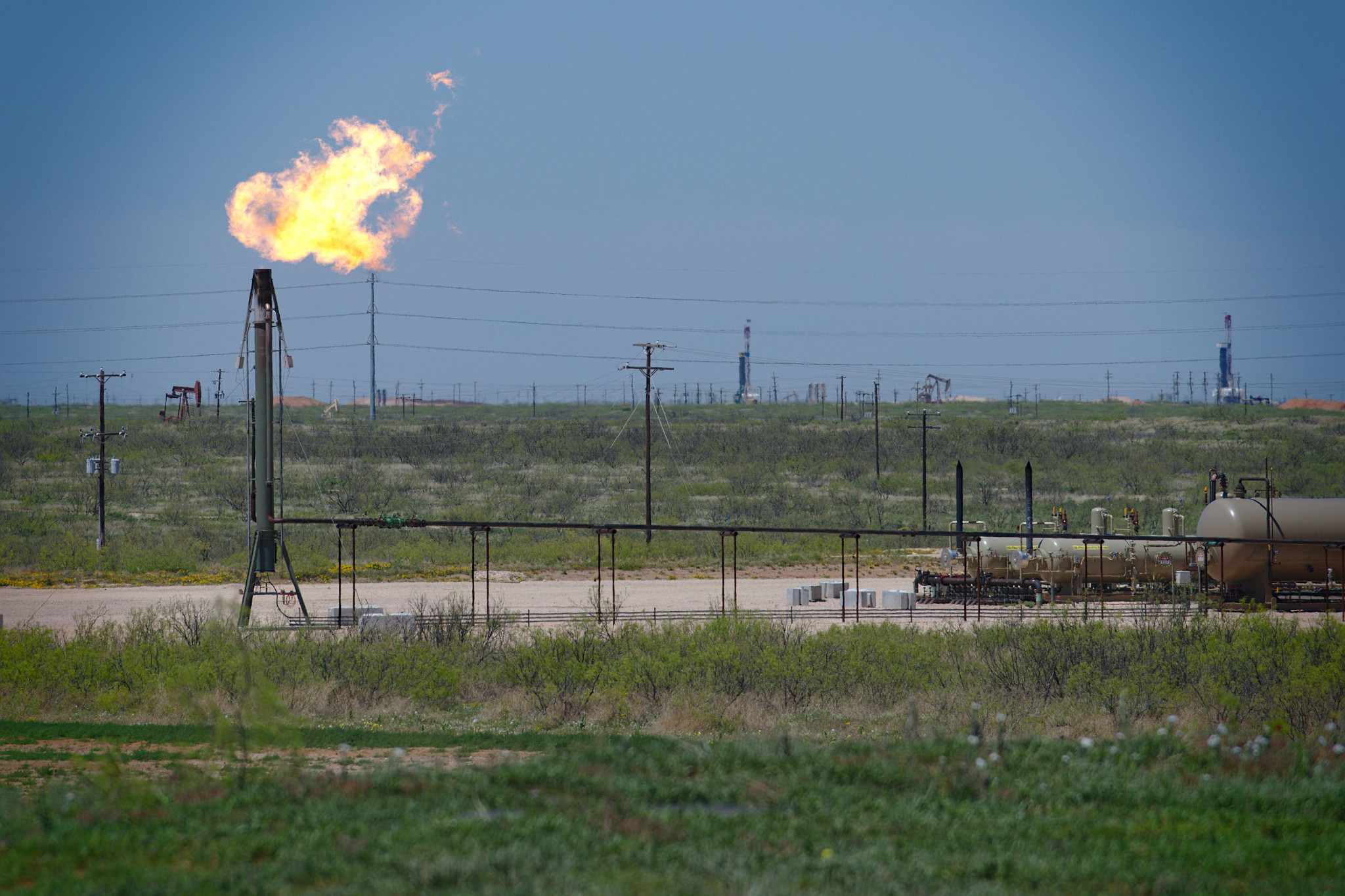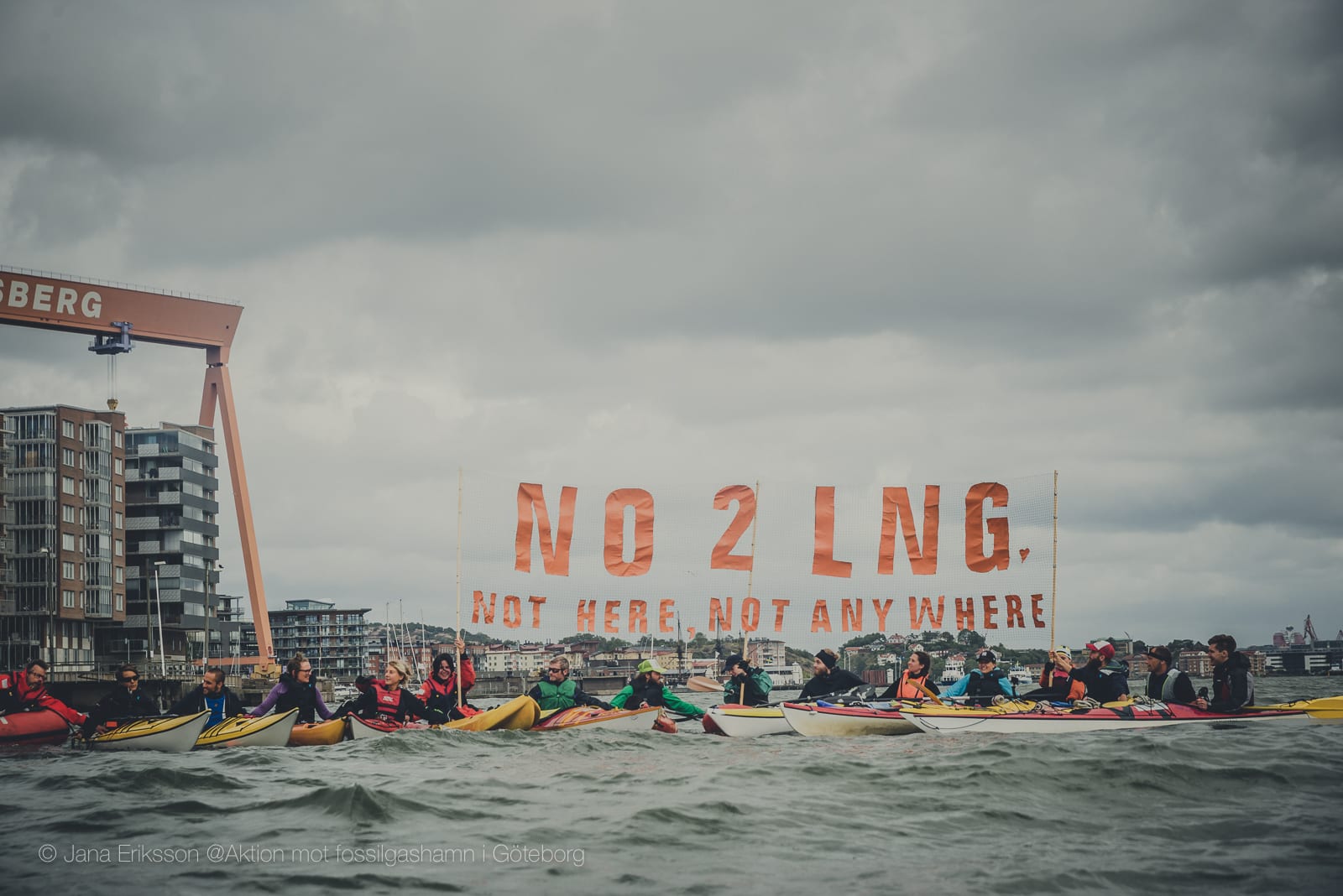Fracking in the Permian Basin
Location:
Texas & New Mexico, USAProject risks:
Environmental Destruction, Social HarmCompanies:
- Vitol Holding II SA
- Mewbourne Holdings Inc
- GBK Corporation
- Talara Capital Management LLC
- NGP Energy Capital Management LLC
- Inner Mongolia Yitai Coal Co Ltd
- Mountain Capital Management LLC
- WhiteWater Midstream LLC
- MPLX LP
- ONEOK Inc
- Marathon Petroleum Corporation
- Targa Resources Corp
- Enbridge Inc
- Enterprise Products Partners LP
- Energy Transfer LP
- Three Span Oil & Gas Inc
- Rockport Oil & Gas LLC
- U.S. Energy Development Corporation
- Petroplex Energy Inc
- Yukon Exploration Operating LLC
- Moriah Energy Investments LLC
- Amtex Energy Inc
- Stephens Natural Resources LLC
- Williams Oil Company
- FourPoint Energy LLC
- IKE Energy LLC
- Langford Energy Partners LLC
- Reliance Energy Inc
- Cutbow Operating LLC
- Granite Ridge Resources Inc
- V-F Petroleum Inc
- Longfellow Energy LP
- PrimeEnergy Resources Corporation
- FireBird Energy II LLC
- Hannathon Petroleum II LLC
- CPX Energy LLC
- Greenlake Energy Holdings LLC
- Mack Energy Corporation
- White Rock Oil & Gas LLC
- Double Eagle Energy Holdings IV LLC
- TXO Partners LP
- Circle-S Energy LLC
- Black Swan Oil & Gas LLC
- SOGC Inc
- VTX Energy Partners LLC
- Evolution Petroleum Corporation
- Formentera Partners LP
- TRP Energy LLC
- Citation Oil and Gas Corp
- Riverbend Energy Group
- Burk Royalty Co Ltd
- RRP Operating LLC
- Surge Energy US Holdings Company
- Civitas Resources Inc
- Point Energy Partners
- Caza Petroleum LLC
- 1920 Energy LLC
- Riley Exploration Permian Inc
- Elevation Resources LLC
- Discovery Operating Inc
- Murchison Oil & Gas LLC
- Nadel and Gussman LLC
- Crescent Energy Company
- HighPeak Energy Inc
- Manti Resources Inc
- UpCurve Energy LLC
- Jetta Operating Company Inc
- Ring Energy Inc
- Hibernia Energy IV LLC
- Bayswater Exploration and Production LLC
- Zarvona Energy LLC
- Permian Deep Rock Oil Company LLC
- Kaiser-Francis Oil Company
- Triple Crown Resources LLC
- Compass Production Partners LP
- Steward Energy II LLC
- APR Operating LLC (Admiral Permian Resources)
- Battalion Oil Corporation
- Summit Petroleum LLC
- Sheridan Production Company III LLC
- Tap Rock Resources LLC
- Maverick Natural Resources LLC
- Discovery Natural Resources LLC
- Spur Energy Partners LLC
- Capitan Energy Inc
- United Production Partners Inc
- Birch Operations Inc
- Sequitur Energy Resources LLC
- Jonah Energy LLC
- Fasken Oil and Ranch Ltd
- Revenir Energy Inc
- Lime Rock Resources
- Northern Oil and Gas Inc
- EnerVest Ltd
- Petro-Hunt LLC
- BTA Oil Producers LLC
- Scout Energy Partners
- Sinochem Group Co Ltd
- Kinder Morgan Inc
- Permian Resources Corporation
- Blackbeard Operating LLC
- Matador Resources Company
- Diversified Energy Company PLC
- Vital Energy Inc
- Chord Energy Corporation
- SM Energy Company
- Mewbourne Oil Company
- Hilcorp Energy Company
- Diamondback Energy Inc
- Continental Resources Inc
- Range Resources Corporation
- Coterra Energy Inc
- Devon Energy Corporation
- APA Corporation
- Ovintiv Inc
- Ecopetrol SA
- EOG Resources Inc
- ConocoPhillips
- Occidental Petroleum Corporation
- BP plc
- Chevron Corporation
- Exxon Mobil Corporation
Approximate location. By zooming in, you can recognize the drill pads of the Permian Basin.
Everything is Bigger in the Permian Basin
In the Permian Basin, almost every harmful aspect of fracking takes on new dimensions. The landscape, the towns, the schools and the air all bear witness to the damages of the US' oil and gas boom. The United States has been the largest producer of hydrocarbons worldwide since 2014, mainly thanks to the utilization of hydraulic fracturing (fracking) on a massive scale.[1][2] In the country’s largest fracking region, the Permian Basin, the catastrophic consequences of the fracking spree on people and nature are omnipresent.
Barely an acre of land has been left untouched by oil and gas companies in the Permian Basin [3] The Permian Basin is a region the size of Great Britain.[4] It stretches across western Texas and southeastern New Mexico.[5] Bobbing pump jacks, processing plants, oil and wastewater storage tanks, compressor stations, artificial waste pits, frack sand mines and dirt roads are everywhere.[6][7] Corridors for underground pipelines create wide strips of barren land that vanish into the horizon.[8]
Note: Reputational risk projects on GOGEL are updated annually. This article was last updated November 4 2025.

265 million years ago, the Permian Basin lay underwater. It was a flourishing coral reef.[9] Although the Permian is a desert today, traces of the coral reef remain.[10] The organisms that once lived there have transformed into enormous deposits of oil and gas.[11] Nearly 40% of all oil produced in the USA comes from the Permian Basin.14663 Currently, over 140 companies are extracting record amounts of oil and gas in the region.[14]14665
To get to the oil in the Permian Basin, companies like Chevron, Occidental Petroleum, EOG Resources, ExxonMobil and ConocoPhillips almost always use fracking. Fracking is an extremely destructive, unconventional way of extracting oil and gas which is otherwise not extractable. Roughly 80% of all fracking worldwide takes place in the US.[16] The largest US fracking regions are Eagle Ford in Texas, the Appalachian Basin in Pennsylvania, West Virginia and Ohio and the Permian Basin in New Mexico and Texas.[17] The Permian Basin is the largest of them all.[18]
The companies in the Permian Basin use fracking because the oil and gas is trapped underground in compressed layers of shale.[19] To crack open the shale, the companies have drilled tens of thousands of fracking wells.[20] They pump truckloads of water, sand and chemicals into the ground to release the oil and gas.[21] One single fracking well can use up to 42,500,000 liters (11,227,312 gallons) of water and up to 14,514,955 kg (32,000,000 lbs) of sand.[22][23] For a single barrel of fracked oil, the companies produce about 4 to 7 barrels of toxic wastewater.[24] The companies dispose of the wastewater in different ways. In some cases, they store it in open pits. These pits frequently leak and contaminate groundwater.1554921423 Often, the companies inject the wastewater back into the ground.[25][26] The pressure from the injected wastewater can cause earthquakes.[27][28][29] The number of earthquakes in the Permian Basin has been increasing since the fracking boom began gathering pace. In Texas alone, there have been approximately 2,900 earthquakes since 2017.14669 Scientists see a clear link to the oil and gas industry - as does the State of Texas. Regulators banned the underground injection of wastewater in a large part of the Permian Basin, but the region continues to be struck by earthquakes.1467121424
A Network of Pollution
The companies transport a lot of the oil and gas from the Permian Basin to the Gulf Coast.[31] From there, a never-ending stream of cargo ships transports it out into the world.[32] However, the companies are producing so much oil and gas that they are running out of pipelines to carry it all to the coast.[33] So, the companies are building more pipelines, oil export terminals, liquefied natural gas (LNG) terminals, gas processing plants and petrochemical complexes as fast as they can.[35][36][37]15551 Rising demand for US natural gas in the wake of Russia’s invasion of Ukraine has further accelerated development of export infrastructure. In 2024, the company DeLa Express announced plans to lay a 690 mile (1110 km) gas pipeline all the way to the Louisiana section of the Gulf coast. In total, 21 LNG export facilities are currently being planned along the US Gulf Coast.21425

The climate impact of Permian oil and gas is even greater than that of coal.[38] Pioneer Natural Resources, Chevron and the other Permian producers simply burn off (flare) excess gas that cannot be directed into pipelines without further treatment.[40]15553 As a result, a constant flow of smoke and flames pollute the air. Large amounts of carbon dioxide are released every day.[41] Sometimes, however, the companies simply release (vent) excess gas into the atmosphere without burning it off.[42] Fossil gas consists mostly of methane, so the companies are actually emitting almost pure methane into the air.[43] Over a period of 20 years, methane is 86 times worse for global warming than carbon dioxide.[44] Even though New Mexico has introduced stricter rules for flaring and venting, many companies are continuing as if nothing changed. Ultimately, there aren’t enough inspectors to enforce the restrictions.15555 Overflight data has repeatedly shown that the biggest methane leaks of all US oil and gas regions come from the Permian Basin.[45]146732142621427 Finally, the US Environmental Protection Agency has decided to act on the situation. The industry is doing all it can to prevent stricter federal rules for ozone and methane emissions.15557

Taking its Toll on the People
Over 2 million people live in the middle of the Permian Basin's seemingly endless expanse of oil and gas infrastructure.[46] Many can see the wells from their kitchen window.[47] Flaring stacks are everywhere. They shoot flames into the air day and night, so it never really gets dark.[48] Sulfurous gas from the extraction sites leaves a heavy stench in the air.[49] It smells like rotten eggs.[50] The smell is sometimes so bad that people cannot go outside.[51] Many wake up with headaches every day, have difficulties breathing, or suffer nausea and dizziness.[52][53]
When there is an accident, the local people pay the price. In January 2020, a wastewater pipeline in Carlsbad, New Mexico burst in the middle of the night across the street from a family’s home.[54] Fracking wastewater is full of salt, toxic chemicals, oil, grease and radioactive minerals.[55] When the pipeline in Carlsbad exploded, this poisonous brew rained down on the family’s home.[56] As they tried to rescue their animals, they were drenched in wastewater.[57] Both grownups and children developed rashes and pustules on their skin.[58] Their efforts to save their animals were unsuccessful and the family had to kill off their chickens, dog and goat.[59] Many fear that wastewater will eventually pollute the groundwater and make it impossible to live in the region.15559 The increasing number of abandoned wells reinforce the residents’ concerns.14679 When oil and gas companies leave, the pressure from the water injections stays below the ground. The abandoned wells become ticking time bombs before some of them pop and spew out toxic water.23329

The advent of fracking technologies and the end of a forty-year embargo on US-crude exports in 2015 resulted in the biggest oil boom the Permian has ever witnessed.2142821429 The shale boom is still transforming the Permian’s towns and cities. Thousands of workers are moving into the region to work the drilling rigs and build pipelines to transport the oil out of the Permian.[61]21430 The small towns lack resources to address the influx of temporary workers.[62] Rents rose by 65% between 2010 and 2018.[64] Hospitals don’t have enough doctors.[65] Schools are too small to accommodate the many children that are moving into the oil region with their parents.[66] In addition, schools are struggling to find new staff as teachers leave for higher-paying jobs in the oil industry or move to more affordable regions.[69]At the same time, most of the oil and gas economy is built on the backs of migrant workers. Latinos make up a large part of the oil and gas workforce in the Permian. Often, they work under dangerous conditions, risking their physical and mental health. A study from the University of New Mexico shows that they also lack economic and educational opportunities, as well as access to health insurance and social benefits.21431
Many people in the Permian Basin are sick and tired of the oil and gas companies. Countless groups and NGOs are protesting against the different aspects of the Permian’s fracking spree. In the Permian Basin itself, civil society groups rally against the companies’ expansion plans and pollution.1556115563[70] Over the years, Wild Earth Guardians and other groups have filed lawsuits against leases and companies operating in the basin, to protect the little liveable environment that’s left.15565155672143221433 Around the Permian, groups are opposing the construction of pipelines that would transport Permian oil and gas.[71] Along the Gulf Coast, other groups fight oil and gas export terminals and petrochemical facilities.14683[73]21434 In reaction to the protests, the state of Texas passed a new law in 2019.[74] Since then, protesters can get 2 years in prison simply for the intent of blocking a pipeline.[75] The vague use of the term “intent” in the law makes any kind of opposition against oil and gas production in the state even riskier.
Since the companies and regional governments do not listen to them, local communities, Indigenous groups, activists and NGOs have also taken their fight abroad. Their plan: If nobody buys the Permian’s dirty fossil fuels, the companies will stop producing them. Together with activists in European countries, they pressure financial institutions and governments to stop backing companies behind proposed LNG terminals in Europe and the US.214352143621437 Many of the terminals are supposed to import fracked gas from the Permian to Europe. The Dutch bank ING recently responded to the massive opposition and committed to stop providing financing to new LNG export terminals.21438

Yet, oil and gas companies in the Permian Basin remain firmly on the course of expansion. They continue to plaster New Mexico and Texas with more and more oil and gas drilling rigs, waste pools, flaring stacks and pipelines. They will continue to pollute the environment, cause earthquakes, accidents and health problems. The companies do not care if hospitals and schools are too small or housing prices too high. The only way to avoid the negative effects of Permian Basin fracking is to leave the oil and gas in the ground.
Check out the video: Permian Climate Bomb
Groups like Oil Change International are spreading the word on the disastrous effects of oil & gas extraction in the Permian Basin.
Groups working on the Permian Basin: Earthworks, Oil Change International, Society of Native Nations, WildEarth Guardians, Center for Biological Diversity, Sierra Club, Western Environmental Law Center, Waterkeeper Alliance, Youth United for Climate Crisis Action (YUCCA), New Energy Economy, Wilderness Society, Environmental Defense Fund, IEEFA, Gardendale Accountability Project, Environment Texas, Society of Native Nations, Texas Campaign for the Environment, Fractracker Alliance, Conservation Voters of New Mexico, New Mexico Interfaith Power and Light, Carlsbad-based Citizens Caring for the Future, Health Action New Mexico, New Mexico Environmental Law Center, New Mexico Voice for the Children, Progress Now New Mexico, 350 New Mexico, 350 Santa Fe, Climate Advocates Voces Unidas (CAVU), Big Bend Defense Coalition, Citizens for Clean Air and Clean Water in Freeport, Texas, Port Arthur Community Action Network (PACAN), San Juan Citizens Alliance, Greenpeace USA
Further Resources: